IJCRR - 2nd Wave of COVID-19: Role of Social Awareness, Health and Technology Sector, June, 2021
Pages: 23-32
Date of Publication: 11-Jun-2021
Print Article
Download XML Download PDF
The Effective Use of Full Online Learning to Replace Classroom Learning During the Covid-19 Pandemic
Author: Hadiyanto, Sovia Wulandari, Liza Septa Wilyanti, Supian, Rengki Afria, Nazarudin
Category: Healthcare
Abstract:Background: The emergence of the Covid-19 pandemic led to the global change of academic learning strategy from classroom to online mode. Before the emergence of the virus, online learning at a medium scale has been implemented to support the educational system in Indonesia. However, due to the pandemic and to reduce the spread of the virus, online learning became the main and sole place of learning. Objective: This study investigates the implementation and effectiveness of online learning at the faculty of humanities at a University in Jambi, Indonesia, since the Covid-19 pandemic. Method: This is quantitative research. Self-report questionnaires with 5-point Likert scales were used to obtain data from 441 respondents by using the Survey Monkey application. Result: The result showed that online learning was not implemented at the top level of 4.20, using an inadequate replacement process. Furthermore, all categories of online learning implementation, such as design, course communication, time management, and technical skills, were not optimally obtained, while the categories were inadequately effective in replacing classroom learning. Conclusion: Online learning was unable to replace classroom learning because its implementation and effectiveness failed to meet policymakers' expectations at the university level. Therefore, there is a need for the increase in teachers' competence and usage intensity regarding online learning in faculties and universities
Keywords: Information technology Skills, Online course design, Higher education, E-learning, Revolution Industry 4.0
Full Text:
INTRODUCTION
In a bid to minimize the rapid spread of the Covid-19 pandemic, the government has issued various policies, such as isolation, use of face mask, online learning as well as social and physical distancing.1,2 The majority of universities in the world changed their learning mode from classroom to online, including those in Indonesia. However, this posed numerous challenges for educational institutions, especially those in universities. In mid-March 2020, the Indonesian Ministry of Education and Culture implemented a learn and work from home policy, which requires people to work, worship, and study from home. The implementation of this policy required all educational institutions to turn all learning processes from classroom to online mode. The Covid19 pandemic and the government's policy forced teachers to apply online learning as a significant classroom source. However, before then, a faculty in a University in Indonesia used online learning at a minimum scale to supplement classroom learning. Currently, online learning as a sole media is implemented at the top level of academic institutions.3
University teachers are not only required to be experts in delivering teaching materials in the classroom, instead, but they also need to be able to use the online learning systems to provide exercises, manage time, design appropriate learning strategies, operate supportive learning applications, etc. Online learning is not accessible due to the complexity associated with the planning, evaluation, and learning processes.4,5 In summary, it needs university teachers to apply their offline pedagogy, in teaching and learning online strategies and skills.
Several studies have discussed and reported the lack of facility and internet connection to carry out online learning, however, studies related to its usage is still lacking. There are three main areas in online learning that teachers need to anticipate, namely teaching materials, student interaction, and learning atmosphere.6 Teaching material plays a significant role in the learning process as a source of study, with interaction outlined as one of the factors used to help students achieve optimal learning outcomes. Teaching material and student interaction also plays an important role in achieving better learning outcomes.7
This research aims to investigate online learning usage and its effectiveness at a University’s faculty during the Covid-19 pandemic. Due to the frequent use of offline learning strategy by most lecturers before the pandemic, their ability to utilize the online learning process becomes questionable. Online learning is a substitute for conventional learning, this means that the interaction between teachers and students and all academic activities is conducted electronically. Finally, this research is expected to specifically contribute to university management, to quality assurance agencies, and prepare teachers for effective online learning strategies at the university.
LITERATURE REVIEW
Online Learning as a Substitution
Online or electronic learning (e-learning) is carried out via globally interconnected computer networks. This e-learning application formally and informally facilitates training and learning activities.6,8 Various applications such as computer-based learning, web-based learning, virtual classroom, virtual Schoology, Virtual Zoom, Edmodo, Moodle, Easy Class, etc can be used for online learning. Some universities have developed their template of e-learning that fit the needs of academic communities on their campus.6
E-learning is an online learning platform created to overcome limitations between educators and students, especially in time and space. Several online learning models can be applied (1) web Course, which is the act of conducting lectures through the internet, is a full online learning strategy with communication patterns between students and lecturers, dominated by remote systems via the web/internet. Furthermore, all teaching materials, assignments, consultations, examinations, and other learning activities are delivered online. (2) Web-Centric Course, which integrates distance learning with classroom using online lectures, with some of the learning processes carried out through face-to-face, and its functions are complementary. (3) Enhanced Web Course is a lecture improved through web/internet utilization. It is the learning reciprocity between lecturers and students as well as learning centred on the web/internet.9,10 There are at least three electronic learning functions (e-learning), namely supplement, complement, and substitution.8 Supplement (additional) is defined as the process where students are free to choose from online learning media. Therefore, there is no requirement for participating students to access the material electronic learning. Complement, means that the material Electronic learning is programmed to be reinforced or remedial for students in participating in conventional learning activities. Substitution, is the use of e-learning as a substitute for conventional lectures, conducted through the electronics media (without face-to-face mode directly in class).
The Indonesian Ministry of Education has implemented a policy for schools to turn physical classroom learning to online to anticipate students' mobility across provinces and regency.11 This is a substitute learning process used to provide students flexibility in managing their learning activities irrespective of their place and time. Teachers are assumed to be able to launch their lesson plan, and split learning topics according to time, and learning materials, with assignments, and quiz used to determine their abilities on the use of eLearning applications, irrespective of time and place.1 However, there is an increase in the optimized use of online learning as a substitute for classroom learning during the Covid-19 pandemics. Teachers need to understand how to use supportive applications such as zoom, Google, etc for adequate interaction with students, this is because having the right skills to operate e-learning is not enough skill for them.
Online learning becomes effective when a teacher can operate and manage learning activities based on internet pedagogical principles as understood and applied in physical classrooms.12,13 With this strategy, achieving optimal learning goals in classroom learning becomes possible because it is similar to the conventional classroom process. The facilities and features of e-learning are provided for teachers to engage students through group discussions, video presentations, providing links to other resources such as YouTube channel, giving assignments, scoring, providing e-library, etc. Teachers can combine the asynchronous and synchronous online learning process to obtain optimal learning effectiveness. Snow and Lakshmi & Chetan stated that teachers are expected to engage students through online learning and create interactive communication.5 Various learning strategies and activities can be organized based on online learning, thereby enabling students to indulge in active learning.14 Broadbent stated that one main characteristic of online learning is allowing students to learn by themselves, with teachers directing the process base on their needs and progress.15
Advantages of online learning
Several studies stated that classroom teaching and learning are still less effective in promoting students learning processes due to time constraints, difficulties, lack of flexibility, fear, etc. Conversely, numerous studies have proved lots of advantages associated with using online learning, such as an increase in the level of interaction between students and teachers, managing to learn anytime and place, wide-coverage, ability to invite students from other countries, reaching a global audience, and simplification of storage and learning material, easy updating of content and achievable capabilities.16 Furthermore, Vanslambroucket al. stated that online learning helps teachers and students to manage learning activities via android, computer, and laptop.17 Online learning acts as a virtual classroom, which allows interaction between students and lecturers and serves as a media that provides learning resources for efficient evaluation.18 The advantages of using online learning for students are high independence and interactivity, increased memory level of the course content, and the ability to provide more learning experience. Online learning allows teachers to combine text, audio, video, and animation while delivering content. It is easy to convey, update, and download. Students can send messages, comment on discussion forums, use chat rooms and a video conference link to communicate synchronously and asynchronously.4,6
Furthermore, the physical classroom learning activities and assignments where students work together can be conducted through electronic, online, or web-based learning. Online learning, such as an E-learning template, is an instructional process that involves electronic equipment in creating, fostering, delivering, assessing, and facilitating a learning process. These learning activities are normally conducted in a conventional classroom, and now they can be applied in online learning as well.16 The advantages are obtained when the teachers have knowledge and skills of online learning usage and the strategies needed for its preparation, management, and application.
Managing Online Learning and Teachers’ Role
A lecturer is a crucial factor in the successful organization of electronic learning activities and they play a very decisive role in motivating students. Therefore, lecturers need to be structural in conveying information on all aspects of learning activities to enable students to achieve adequate knowledge. They also need to possess higher skills in operating online learning applications to optimize the facilities and features. The techniques used by teachers to facilitate students understanding are different between classrooms and online. Teachers' are assigned the role of mentoring rather than giving lectures, and are less of disseminators and more facilitators. Before starting online courses, teachers need to search for related materials and ideas, design lesson plans that can be replicated and emulated, as well as exercise, quizzes, and tests for evaluation purposes. Furthermore, they need to design strategies and methods, to deliver the content by selecting tools and applications. The learning design needs to engage students in learning activities, interact, and acquire the necessary content. Finally, evaluations need to be regularly conducted to determine their progress.18
Teachers and students play respective roles in facilitating online learning activities. In addition, students play the role of knowledge constructor, skills practiser, independent learners, and problem solvers.2 It is a teachers' responsibility to ensure students interact among themselves while learning online to help them acquire more knowledge and achieve maximum objectives. The interaction between students and students need to be always built to improve communication and discussion about learning activities.7 For example, when students are unable to understand a question or an idea, they can ask others for explanations. However, when the answers are unable to solve the problem, then the teachers need to provide answers with detailed explanation. This interaction among the students and teachers need to be maintained for better learning outcomes.
Online Learning Principles and Criteria
Hadiyanto, Broadbent, and Cable et al. stated that adequate attention needs to be paid to the principles of online learning before the class starts.6,12,14 The first is learning materials, and exercises need to be evaluated to provide the right module accompanied by evaluation questions and courses at the end of the semester. These results can be used as a benchmark to score students. The second is a classroom or course community that enables students to develop online communities to interact, support, and share beneficial information with their communities or course members. Thirdly, teachers are allocated time to stay online to give students direction, answer questions, and help in discussions. Fourthly, students are opportune to work together online, with supportive applications set for online meeting, therefore, they can meet simultaneously in real-time without constraints due to distance. The fifth is associated with the use of technology audio and video delivery material to attract students' interest in learning. Furthermore, three main criteria need to be paid attention to when dealing with online learning. Firstly, online learning is a network that enables the ability of courses to be uploaded, saved, distributed, and shared quickly within a wide range. This criterion is very important in online learning and an absolute requirement. Secondly, online learning connects users via applications in the laptop, desktop, and android using standard internet technology. Thirdly, online learning is the most extensive learning method with solutions exceeding the traditional paradigm.20
MATERIALS AND METHODS
This is quantitative research with the questionnaire method used to obtain data from 1189 students of the Faculty of Humanities at a University in Indonesia. Out of the 1189 students, 441 participated in the online survey, with data collected using the SurveyMonkey application. Furthermore, self-report questionnaires with 5-point Likert scales were developed to measure online learning's usage and effectiveness. The questionnaire consisted of two parts, with the first used to gather students' demographic background, while the second was used to obtain their responses on the use of online learning. Furthermore, the use of online learning was classified into 5 constructs, namely, design, communication, resource authenticity, time management, and technical skills. The questionnaire was developed based on literature studies.4,10,12,13 The workshop was carried out twice to evaluate the questionnaire's constructs and elements until it was used for the data collection.
About reliability and validity testing, it is proposed that Cronbach alpha with a coefficient value of 0.60 consisting of 10 elements and below, while 0.70 was recommended for more than 10, despite accepting 0.30. In this study, consistency analysis based on the overall instrument of Online learning usage led to a Cronbach alpha coefficient value of 0.956.21,22 Further evaluation indicated that all sub-components in online learning had corrected item-total correlation at 0.30 and α level above 0.60. In simpler terms, the instruments were known to be reliable and valid for measuring online learning usage, as shown in Table 1.
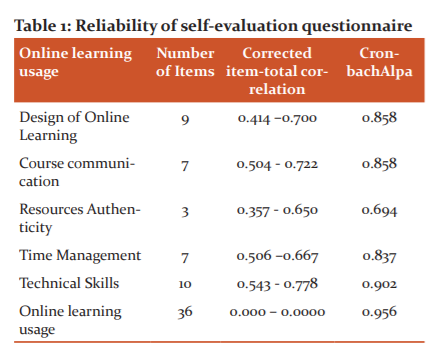
The descriptive statistic and Pearson correlation were used to report the result. Furthermore, descriptive analysis, frequency, percentage, and mean score were used to report the level of online learning usage and its' effectiveness. The mean score of the respondents' level of instructional practices is descriptively calculated and interpreted in five levels, as shown in Table 2.
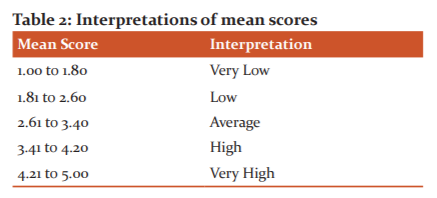
Table 2 shows that the mean score between 1.00 and 1.80, 1.81 and 2.60, 2. 61 and 3.40, 3.41 and 40 as well as 4.21 and 5.00 had very low, low, medium, high, and very high levels of core competencies.
Person correlation was applied to analyse the relationship between online learning users with the effectiveness of replacing face-to-face learning during the Covid-19 pandemic. A p-value of 0.001 was used to judge the significances of the Correlation coefficient (r) index. The relationship between two variables can be obtained from -1.00 through 0 to +1.00, inclusive. The greater the coefficient's absolute value, the stronger the relationship.21
Respondent Profiles
The respondents' profiles in terms of the gender indicated that 156 (35,4%) participants were male and 285 (64.6%) females. In terms of the program, 77 (17.5%) of the participants were at Indonesian Literature, 111 (25.2%) art, drama and music, 72 (16,3%) archaeology, 104 (23.6%) history, and 77 (17.5%) Arabic education. In terms of year of study, 153 (34.7%) were in the first year, 131 (29.7%) in the second year, 90 (20.4%) third year, 40 (9.1%) in the fourth year and 27 (6.1%) in the fifth year.
RESULTS
Table 2 provides an answer to the question, "When is online learning intensively applied to teaching and learning at your program? The findings showed that 420 (95.2%) out of 441 respondents used online learning intensively since the emergence of the Covid-19pandemic crises, and only 5% stated that they started using the process since their first semester. The finding implied that online learning intensively used for teaching and learning at the faculty was since the covid19 pandemic.
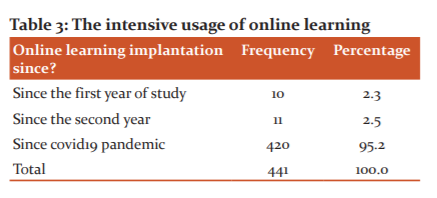
Figure 1 shows the overall usage and effectiveness of online learning for replacing classroom learning during the pandemic at the faculty of a University in Indonesia. Students' perception of online learning usage had an overall mean of 3.53 and at a high level. However, on the contrary, the usage effectiveness was rated at the average level of 3.15 and in the lower mean category. In terms of components, students rated implementation of the design of online learning was at a high level (3.51), while the effectiveness was rated at an average level (3.15), course communication was high (3.67), and its effectiveness was at an average level (3.25). Furthermore, their resources authenticity was at a high level (3.56), while its effectiveness was lower (3.42), time management (3.45) was at a high level, while its' effectiveness was average (3.21), technical skills were rated high (3.40), while the effectiveness was average (3.18). The finding indicates that despite the university's policy for full use of online learning during the pandemic, it did not obtain the maximum level and is not highly effective.
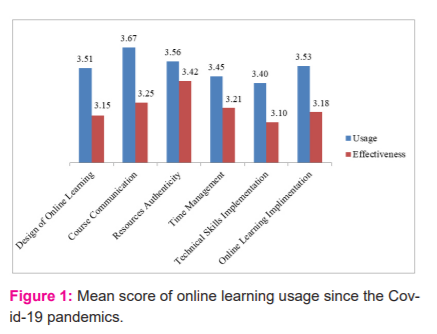
General Implementation of Online learning
Table 4 displays that online learning's general implementation was at a high level of the mean score (3,51). Students rated A1, A2, and A4 at the average level, while A3, A4, A6, A7, A8, and A9 were high. Students implied that the implementations of online learning based on the statement are at a high level. However, there is no mean score of general implementation statements rated at a very high level. Furthermore, they stated that all elements of online learning were not highly effective. The findings showed that online learning's general implementation was not optimally applied at the faculty, even during the pandemic.
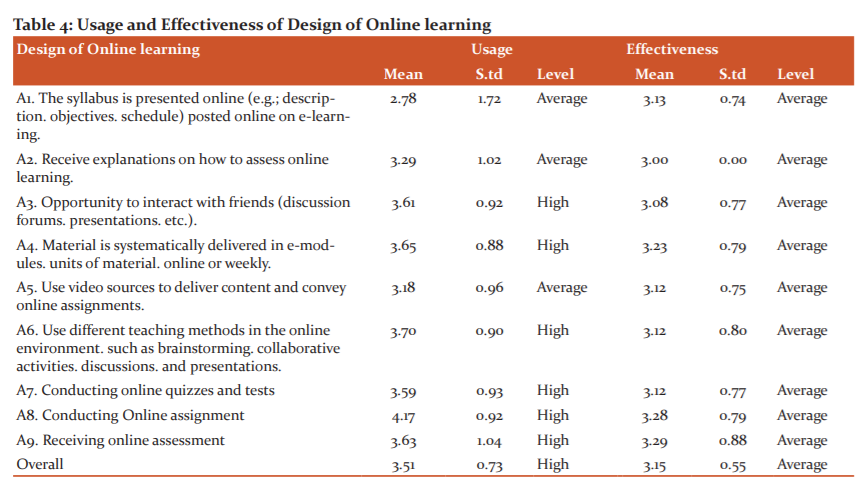
Table 4 shows the result of online learning implementation in terms of course communication, which had a high overall course level of the mean score (4.01). Students also rated all statements regarding course communication high, while all elements' effectiveness was rated average. The findings indicated that online learning's course communication was not optimally applied and ineffective compared to students' and teachers' communication.???????

Resources authenticity is one of the components widely investigated in this study. The question "Are the authentic resources and academic standard applied in online learning activities?" needs to be determined. The findings show that high authentic resources (3.56) were applied in the teaching and learning process. However, two statements (C1 and C2) led to a high mean score of authenticity and one statement at an average mean score of 3.00. Furthermore, the effectiveness of authentic resource usage was also rated at a high level (3.42), while C1 and C2 produced effective high mean scores, and one statement (C3) was at an average level (3.30). The finding in Table 6 showed that resource authenticity was not very strongly and effectively emphasized during teaching and learning and carrying out students' assignments.

Table 7 shows that time management of online learning was at the bottom of the high level of the mean score (3.45). Students rated four statements of time management, namely D1, D2, D3 and D4 at the average level. Three other time management statements, namely D2, D3, and D5 were rated at a high level, while none were very high. Therefore, the effectiveness of applying time management application and its elements were rated at the average level. The study indicated that teachers' time management needs to be repaired to positively impact students' learning activities since the effectiveness level was average for the overall elements of effectiveness.

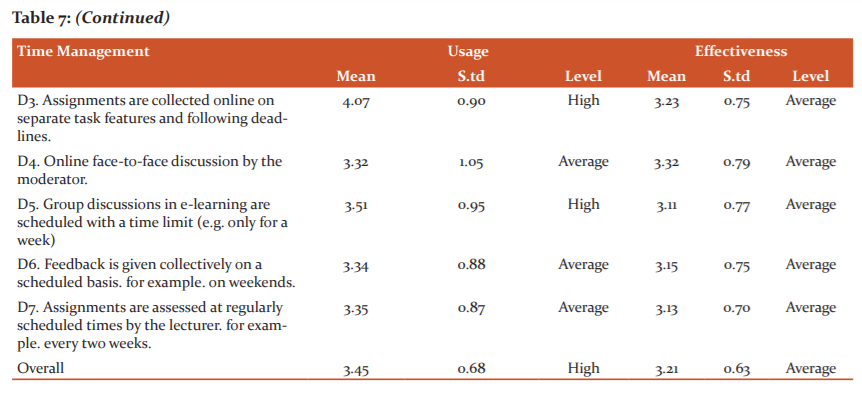
Table 8 shows that the research findings in terms of technical skills in online learning implementation have an average level of the mean score (3.40). Furthermore, students' rated 8 out of 10 statements with the use of technical skills in the implementation of online learning (E2, E4, E5, E6, E7, E8, E9, and E10) at an average level. Two other technical skills implementation, namely E1 and E3, were rated very high, with no mean score, and time management statements rated very high. Therefore, the effectiveness of overall technical skills implementation and its elements were rated averagely. The findings implied that online learning's technical implementation needs to be optimally applied and expected to boost the students' learning effectiveness online.
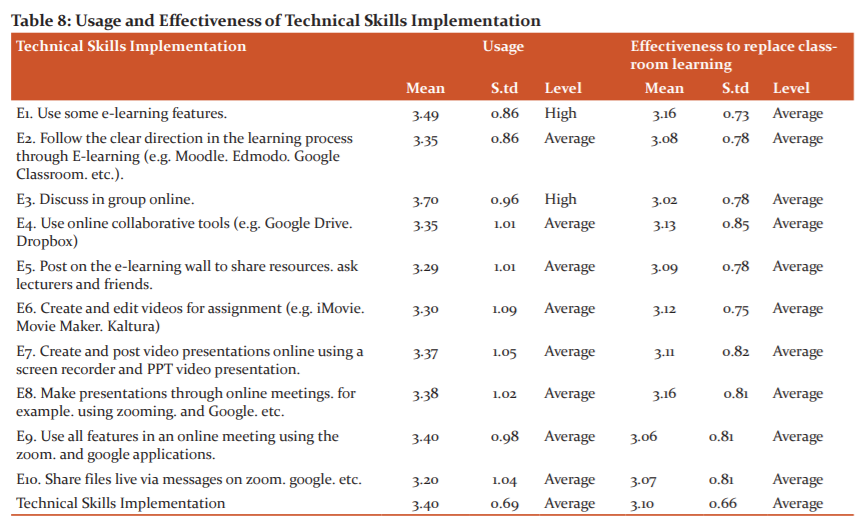
Correlation of usage and effectiveness of online learning
Person correlation was used to investigate the relationship between online learning usages and its effectiveness in replacing classroom learning. The result shows that the use of overall online learning has a significant relationship with effectiveness (r= 0.605, sig. (p).= 0.000< 0.05). There was also a significant relationship between the elements of the design of online learning and effectiveness (r= 0.605, sig. (p).= 0.000< 0.05), course communication and effectiveness (r= 0.605, sig. (p).= 0.000< 0.05), resources authenticity, and effectiveness (r= 0.605, sig. (p).= 0.000< 0.05), time management and effectiveness (r= 0.605, sig. (p).= 0.000< 0.05) and technical skills implementation and effectiveness (r= 0.605, sig. (p).= 0.000< 0.05). These findings implied that the higher the online learning usage, the greater the effectiveness of online learning for replacing classroom class.

DISCUSSION
The research shows that the overall teachers' online learning was at a high level, while the use in replacing classroom learning satisfied students. In more specific ways, the design of online learning, course communication, resource authenticity, and time management was not fully applied by teachers. Furthermore, technical skills were considered an important factor used to facilitate and encourage students to learn. Moreover, students perceive online learning as ineffective in learning and delivering course content. Each implemented components were not significant enough to help students fully learning online. Therefore, online learning is unable to replace conventional learning.
Online learning or e-learning assists students in improving quality learning, however, its usage cannot replace classroom learning.10 Other evidence thereby causes unsatisfied online learning usage at the faculty, which indicates that not all teachers' apply online learning. Teachers' competence using online learning features, which are supported by the application, was also low, therefore, the implementation result of online learning at the faculty was not maximal and ineffective. This is in line with Rapanta et al. research, which stated that some teachers effectively failed to implement the e-learning process.15 This also confirmed by other findings, which stated that lack of teachers' competence in online learning is one factor responsible for the poor utilization of online learning during the Covid-19 pandemic. Therefore, the full replacement of classroom learning with online learning is less possible.16
Teachers need to present an online syllabus to let students know the description, objectives, topic, and lecturing schedule of an online assessment. The use of video as a media means to convey messages is also lacking and needs to be inserted into the online design. This is because the use of video helps improve students' understanding and comprehension of the topic. It also allows them to interact and discuss with friends e-modules and use different online teaching methods to brainstorm collaborative activities and give online quizzes, tests, and assignments. However, due to the need to produce online learning, teachers need to optimize these issues in design.
In terms of course communication, all elements were not very highly applied by the teacher because they used both email and WA as alternative tools for announcements, reminders, and communication. Therefore, to obtain a level of commitment, there needs to be high effectiveness of course communication.7 Teachers also need to be more intense in creating and moderating the discussion, responding to students' questions promptly, providing feedback on assignments, using synchronous web-conferencing tools, and communicating their expectations on student behaviour.
The authenticity results of online learning places more control on original resources and the application of academic standards. The use of authentic material, resources, and online references with copyright is needed to provide attention. This provides emphasis on the use of authentic resources, which is important to ensure students use the academic standard of their assignment resources.13 Time management needs to be properly organized and scheduled for the punctual provision of the online syllabus, for students and teachers to be more ready with topics and activities. To improve the effectiveness of online learning, it is necessary timing for online live discussion to be optimally carried out to produce space for students to interact and communicate with the topic directly.13 Scheduling and timing feedback, assessing assignments, and asynchronous and synchronous discussion are essentially organized better.
Good implementations of technical skills are indicated by clear direction, optimally used for the provision of collaborative tools, updating resources, and enabling students to communicate and discuss with lecturers and friends. Other important factors that support students' effective learning process are creating and editing videos for assignments, online video presentations, optimizing e-learning features, and online meeting application (zoom, google meeting, etc.). E-learning based on online learning needs to be used optimally designed with features and other supporting applications for students' collaboration, cooperation, interaction, communication, discussion, and integration.23 The maximal effort of teachers leads to optimal online learning usage, thereby obtaining the effectiveness of online learning.
General Implication
Identifying lecturers' level of online usage in course communication, resource authenticity, time management, and technical skills is a pervasive step towards full online learning usage in universities' teaching and learning process. As the human resources, the lectures directly utilize the technology in a teaching and learning process. Therefore, their inability to understand and possess adequate skills to operate online learning leads to its unsuccessful implementation.17 The long-term success of implementing a policy is largely dependent on the abilities to support staff on the use of the online application in the teaching process, thereby making the environment stable and reliable.
The crucial problem associated with online learning usage in the higher education sector is lecturers' poor skills in operating technological devices. The low level of lecturers' knowledge and skills in online learning usage is also an obstacle in implementing and impacting learning goal achievement. When the lecturers are not willing, unmotivated, lack awareness, knowledge, and skills to use the online learning application for teaching and learning, the learning process becomes ineffective and inefficient. The outcome is not optimally obtained.
As higher education institutions strive to meet the Covid-19 pandemic situation's needs, they face challenges associated with the full application of online teaching-learning. However, more higher education institutions are required to adopt and adapt to the delivery of courses to students online. The lecturers' awareness, knowledge, and skills assessment need to be evaluated toward online learning implementation, which needs to be conducted on tight and regular schedules. The online learning usage is implemented, and human resources are vital for its preparation and change. Consequently, lecturers as human resources that are directly in contact with the implementation need to possess good level of online learning knowledge and skills in order to contribute to effective implementation. Bao (2020) stated that most teachers’ were unprepared to use online learning during the pandemic.20
CONCLUSION
Due to the inception of the Covid-19 pandemic, universities have changed from classroom learning mode to full online learning in a bid to minimize the spread of the virus. However, the study concludes that online learning usage associated with the general implementation, course communication, resource authenticity, and time management, particularly for technical skills, are not optimally implemented at the faculty level in Universities. Therefore, lecturers need to pay attention, apply, and evaluate the necessary indicators required to obtain online teaching and learning goals. Furthermore, policymaker needs to take into account various solutions and steps as future projections. Obstacles, solutions, and projections of brave learning to prospective teachers are important to learn because the online learning system is presently by lecturers in institutions due to the outbreak of Covid-19.
ACKNOWLEDGMENT
This research was funded by the Research centre of the Universitas Jambi, Indonesia.
Conflicts of interest: The study had no conflicts of interest.
Source of Funding: DIPA of Universitas Jambi, Fiscal Year/No. 2020SP DIPA-O23.77 .2.67756512020
Authors contribution: The first author was responsible for the whole process of writing this paper. Co-authors had contributed to the process of writing this paper, data collection, data analysis, checking references, and formatting of this paper.
References:
1. Basilaia G, Kvavadze D. Transition to Online Education in Schools during a SARS-CoV-2 Coronavirus (COVID-19) Pandemic in Georgia. Pedagog Res. 2020;5(4).
2. Edelhauser E, Lupu-Dima L. Is Romania prepared for learning during the COVID-19 pandemic? Sustain. 2020;12(13):1–30.
3. Baker CN, Peele H, Daniels M, Saybe M, Whalen K, Overstreet S, et al. Trauma-Informed Schools Learning Collaborative The New Orleans show lessThe Experience of COVID-19 and Its Impact on Teachers’ Mental Health, Coping, and Teaching. School Psychol Rev. DOI: 10.1080/2372966X.2020.1855473.
4. Online learning, teaching and education continuity planning for schools. Int Baccalaureate Organ. 2020;1–13.
5. Sankar LS, Sankar C. Comparing the Effectiveness of Face-to-Face and Online Training on Teacher Knowledge and Confidence. Proc 2010 InSITE Conf. 2010;(2001):667–91.
6. Hadiyanto. The EFL Students’ 21 st Century Skill Practices through E-Learning Activities. 2019;3:2580.
7. Lin E, Lin CH. the Effect of Teacher-Student Interaction on Students’ Learning Achievement in Online Tutoring Environment. Int J Tech Res Appl. 2015;22(22):19–22.
8. Scagnoli NI, Bukti LP, Johnson SD. The influence of online teaching on face-to-face teaching practices. J Asynchronous Learn Networks. 2009;13(2):115–28.
9. Michinov N, Brunot S, Le Bohec O, Juhel J, Delaval M. Procrastination, participation, and performance in online learning environments. Comput Educ. 2011;56(1):243–52.
10. Owens JD, Price L. Is e-learning replacing the traditional lecture? Educ Train. 2010;52(2):128–39.
11. Ministry of Education and Culture of Indonesia. Guidelines for Implementing Curriculum in Education Units in Special Conditions, number 719 / P / 2020. Jakarta: Ministry of Education and Culture of Indonesia; 2020.
12. Cable J, Cheung C. Eight Principles of Effective Online Teaching: A Decade-Long Lessons Learned in Project Management Education. World J Eight Princ Eff Online Teach. 2017;VI(Vii):1–16.
13. Andrade MS. Effective eLearning and eTeaching — A Theoretical Model. E-Learning - Instr Des Organ Strateg Manag. 2015;
14. Broadbent J. Comparing online and blended learner’s self-regulated learning strategies and academic performance. Internet High Educ. 2017; 33:24–32.
15. Rapanta C, Botturi L, Goodyear P, Guàrdia L, Koole M. Online University Teaching During and After the Covid-19 Crisis: Refocusing Teacher Presence and Learning Activity. Post digital Sci Educ. 2020;2(3):923–945.
16. Vanslambrouck S, Zhu C, Lombaerts K, Philipsen B, Tondeur J. Students’ motivation and subjective task value of participating in online and blended learning environments. Internet High Educ. 2018;36:33–40.
17. Ananga P, Biney IK. Comparing Face-To-Face and Online Teaching. MIER J Educ Stud Trends Pract. 2017; 7:165–179.
18. Mayer RE. Multimedia learning. Psychol Learn Motiv - Adv Res Theory. 2002;41:85–139. 20. Bao W. COVID-19 and online teaching in higher education: A case study of Peking University. Hum Behav Emerg Technol. 2020;2(2):113–5.
19. Hadiyanto, Failasofah, Armiwati, Abrar, M. and Thabran, Y. Students’ Practices of 21st Century Skills between Conventional learning and Blended Learning. J University Teach Learn Pract. 2021;18(3):7-19.
20. Paechter M, Maier B. Online or face-to-face? Students’ experiences and preferences in e-learning. Internet High Educ. 2010;13(4):292–7.
21. Hair JE, Anderson RE, Tatham RL, Black WC. Multivariate Data Analysis. Ed .5th. Upper Saddle River: Prentice-Hall. 2006.
22. Pallant J. A Step by Step Guide to Data Analysis Using SPSS Program. Survival Manual.4th Edition. China: Everbest Printing. 2011.
23. Al-Maqtri. How Effective is E-learning in Teaching English? A Case Study. J Educ Hum Dev. 2014;3(2):647–669.
|






 This work is licensed under a Creative Commons Attribution-NonCommercial 4.0 International License
This work is licensed under a Creative Commons Attribution-NonCommercial 4.0 International License